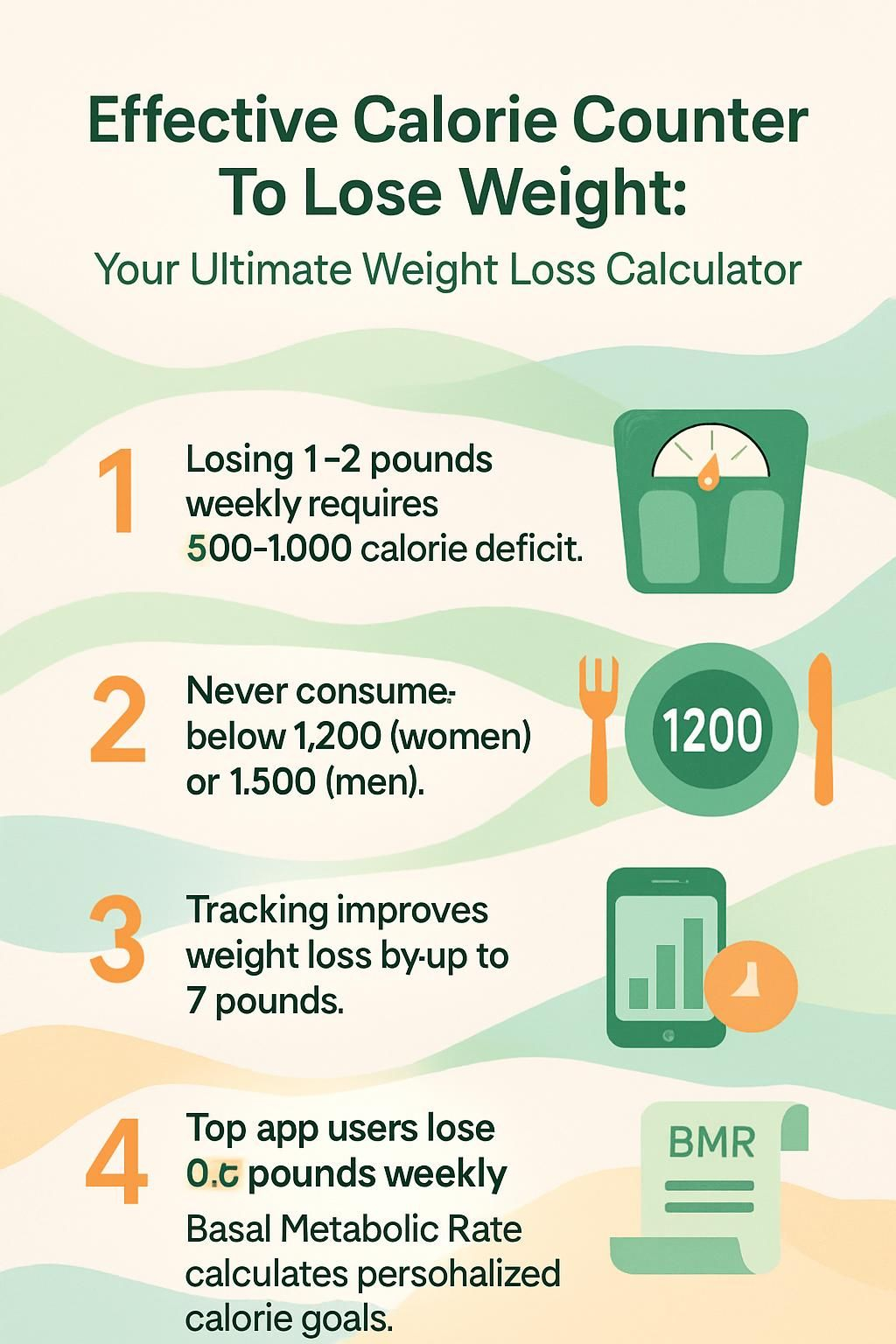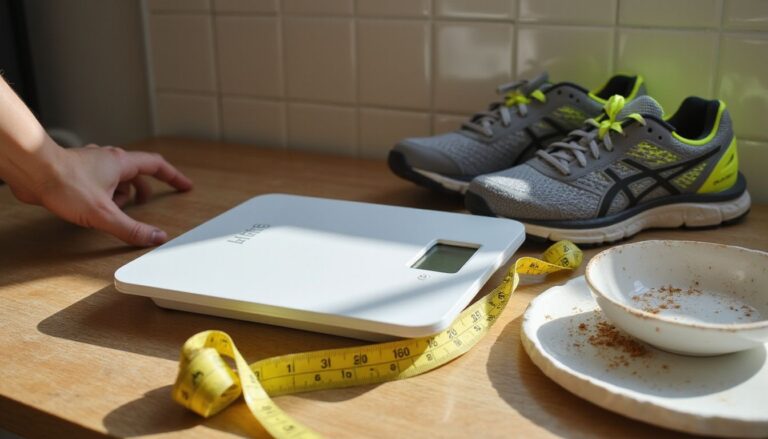Effective Calorie Counter To Lose Weight: Your Ultimate Weight Loss Calculator
Our Nutrition Assistant AI Suite will transform your body. You will lose fat, get toned, and build muscle. Gain confidence and optimal health.
Trying to lose weight without seeing progress can feel discouraging. A calorie counter helps you track how many calories you eat per day and shows how many calories you need for your goal. Using a simple calorie calculator gives you clear targets, steady feedback, and a plan you can follow each day.
This guide walks you through setting realistic calorie goals, safe weight loss steps, and daily tracking with a fitness app. You will learn how to estimate your daily calorie needs, build a calorie deficit, and adjust as your routine changes. Use these tips to start strong and keep moving forward.
Key Takeaways
- Tracking with a calorie counter or app improves accuracy and supports more weight loss. Users who monitor intake regularly can lose about 7 extra pounds, based on the Journal of Diabetes Research.
- A safe weight loss rate is 1 to 2 pounds per week. That usually requires a 500 to 1,000 calorie daily deficit. Do not go below 1,200 calories for most women or 1,500 for most men, per Harvard Health.
- Apps like MyFitnessPal and Lose It! offer large food databases and barcode scanning. Lose It! data shows top users average about half a pound lost per week over roughly 187 days.
- Estimating your Basal Metabolic Rate with formulas like Mifflin-St Jeor, then multiplying by activity level, gives a personalized daily target.
- Consistent logging builds awareness, improves portion control, and supports long-term weight management.

What is a Calorie Counter?

A calorie counter is a tool that records the calories you eat per day. It helps you see your actual intake and compare it to your needs. Many people use a weight loss calculator or a calorie tracking app to set targets and track progress.
What is a calorie counter and how does it work?
You enter basic details such as age, sex, height, weight, and activity level. Most tools let you choose US or metric units. The calculator estimates your Basal Metabolic Rate, or BMR. BMR is the calories your body needs at rest for vital functions like breathing and circulation.
Common formulas include Mifflin-St Jeor, Harris-Benedict, and Katch-McArdle. After BMR, the calculator multiplies by an activity factor to estimate daily needs for maintenance or weight loss. You can view results in calories or kilojoules.
Apps like MyFitnessPal and Fitbit then track what you eat. If your goal is to lose 1 pound a week, the tool often recommends about 500 fewer calories per day. Many online calculators show results instantly without storing personal data.
I used a free tracker during my first serious attempt. Seeing the numbers change each day kept me focused on my plan.
Seeing your calorie intake laid out makes it easier to spot high-calorie snacks that stall progress.
How can calorie counters help with weight loss?
Calorie counters remove guesswork. They show how many calories you eat per day and how many calories you need to lose weight. To lose about one pound per week, you usually need a 500 calorie daily deficit because one pound of fat is roughly 3,500 calories.
Reliable calculators use equations like Harris-Benedict to estimate BMR, then apply activity multipliers. Tracking helps you spot high-calorie choices fast. You can swap them for foods that are higher in nutrients and more filling, like lean protein, vegetables, and whole grains.
Many apps show estimated calorie burn from exercise. That helps you plan meals around activity. If you keep calories below what your body burns, you create a calorie deficit. With steady tracking and portion control, that deficit supports gradual, sustainable fat loss.
The Importance of Calorie Counting for Weight Loss
Calorie counting gives you a clear picture of daily intake and needs. That clarity helps you set targets, check progress, and make smart changes before problems grow.
What is a calorie deficit and why does it matter?
A calorie deficit means you eat fewer calories than your body uses. Your body then uses stored fat for energy, which leads to weight loss. Cutting about 500 calories per day often results in roughly one pound lost per week.
To protect health, Harvard Health suggests most women eat at least 1,200 calories per day and most men at least 1,500. Losing more than 2 pounds a week can increase the risk of muscle loss and poor nutrition. Slow and steady progress is easier to maintain for most people.
Using a calorie counter and a weight loss calculator helps you set a safe target and track it day by day.
How does tracking calories support effective weight management?
Most people underestimate intake, especially from snacks and drinks. Tracking shows true numbers and closes the gap between what you think and what you eat. That improves decisions and helps you hit your daily goal more often.
Research reported in the Journal of Diabetes Research links consistent self-monitoring with about 7 more pounds lost compared to not tracking. Apps make logging faster, including meals from restaurants, which are often much larger than home portions. Weekly goals and same-day weigh-ins help keep your plan on track and support long-term success.
How to Calculate Your Calorie Needs
To estimate your needs, calculate your BMR, then adjust for activity. A calorie calculator turns those numbers into daily targets for maintenance or fat loss.
Understanding Basal Metabolic Rate (BMR)
BMR is the energy your body needs at rest. It keeps your heart pumping, lungs working, and blood moving. The Mifflin-St Jeor Equation is widely used and is considered accurate for most adults.
For men, it is: BMR = 10W + 6.25H – 5A + 5. For women, it is: BMR = 10W + 6.25H – 5A – 161. W is weight in kilograms, H is height in centimeters, and A is age in years. The Katch-McArdle formula uses lean body mass, but it requires a body fat estimate.
BMR often drops with age as muscle mass declines. Knowing your BMR gives you a starting point to calculate how many calories you need per day to maintain or lose weight.
Calculating Total Daily Energy Expenditure (TDEE)
TDEE is your daily burn including all movement. You get it by multiplying your BMR by an activity factor that matches your lifestyle. Sedentary is about 1.2. Light activity is about 1.375. Moderate activity is about 1.55. Very active is about 1.725. Extra active can be up to 1.95.
If you do light chores or walk casually, use light activity. For brisk walks or water aerobics on several days, choose moderate. For frequent hard training, choose vigorous. Many calculators use these factors and round to the nearest 50 calories for easier planning.
Recheck your activity level when your routine changes. Keeping TDEE accurate helps your plan stay effective and safe.
How to adjust calories for your weight loss goals
To lose one pound a week, aim for about 500 fewer calories than your TDEE each day. For two pounds, the usual range is a 1,000 calorie daily deficit. Most women should not drop below 1,200 calories. Most men should not drop below 1,500 calories.
If progress stalls, reduce intake by another 100 to 200 calories or add activity. You can try zigzag calorie cycling. Eat a bit more on hard training days and a bit less on rest days, while keeping your average deficit for the week.
Track your results with a calorie tracking app like MyFitnessPal or Google Fit. Adjust goals as your weight, fitness, or schedule changes.
Types of Calories and Their Effects on the Body
All calories provide energy, but not all foods support health the same way. Choices affect hunger, energy, and long-term results.
What are macronutrients: protein, carbs, and fats?
Macronutrients are the main nutrients your body needs in large amounts: protein, carbohydrates, and fats. Protein and carbs provide about 4 calories per gram. Fat provides about 9 calories per gram.
You need all three for muscle repair, brain function, and cell health. There is no single perfect mix for everyone. Many people feel full longer when meals include protein and fiber.
Unprocessed foods usually offer more nutrients per calorie. Fiber and chewing can raise the energy needed for digestion. For example, 500 calories of carrots are harder to overeat than 500 calories of cake. During one training block, I used a tracking app with interval workouts. Combining protein-rich meals with fiber made portions easier to manage.
What’s the difference between empty calories and nutrient-dense calories?
Empty calories come mostly from added sugars and solid fats. Soda, candy, alcohol, and many packaged snacks fit this group. They add energy but provide few vitamins or minerals. In the United States, beverages can make up a large share of daily calories for many people.
Nutrient-dense foods deliver vitamins, minerals, and other helpful nutrients along with energy. Examples include vegetables, fruits, whole grains, beans, nuts, seeds, and avocado. Some healthy foods are still high in calories, so portion control matters.
One well-known case showed weight loss from eating mainly snack cakes. Weight went down, but health risks likely increased. For most people, a mix of nutrient-dense foods supports weight, energy, and overall health.
Using a Calorie Calculator to Lose Weight
A calorie calculator turns your stats into a daily target. It helps you set a goal calorie level that points straight at your weight loss goals.
How to set your current weight and goal weight
Weigh yourself to get your current weight. Enter it along with your goal weight in the calculator. Most tools also ask for a target date. That creates a timeline and a daily calorie recommendation.
Set a realistic target. Many adults do well aiming to lose 5 to 7 percent of starting weight. This range can lower diabetes risk when combined with at least 150 minutes of exercise per week. Lose It! reported that users who lost about half a pound per week reached goals in roughly 187 days.
Weekly weigh-ins are often better than daily ones due to water shifts and meal timing. In my experience with MyFitnessPal, clear milestones kept me focused and calm between check-ins.
How to determine a realistic timeline for weight loss
Aim to lose 1 to 2 pounds per week as the CDC recommends. Start by targeting 5 to 10 percent of your current weight over a few months. A short and aggressive timeline often forces calories too low and raises the risk of undernutrition.
Use a calorie counter calculator based on your current weight, activity level, and desired rate of loss. Check your monthly results. Adjust timeframes and calories if you see too much hunger or too little progress. You will learn what pace fits your life.
How to adjust calorie intake based on activity level
Activity changes how many calories you need per day. Sedentary users can start with a 1.2 multiplier. If you walk 1.5 to 3 miles per day, a 1.55 factor fits many people. For regular vigorous training or walking more than 3 miles daily, use higher multipliers, up to 1.95.
On busy days, you may increase calories slightly to support energy and recovery. On rest days, you can trim intake to keep your weekly average on target. I found this zigzag style helps match hunger to training, which cut late-night snacking.
Update your entries as routines change. Most calculators round to the nearest 50 calories, which makes daily planning simpler.
Sample Calorie Goals for Weight Loss
Structured plans give you a starting point. Use these calorie levels to practice portion sizes and meal balance before making fine adjustments.
What does a 2000-calorie plan look like?
A 2,000-calorie plan often maintains weight for many adult men, though needs vary. A sample day might include protein-rich breakfast items, a balanced lunch with whole grains and lean meat, and a dinner with a palm-size protein, brown rice, and vegetables.
- Breakfast: two slices whole wheat toast with peanut butter, Greek yogurt, and fruit.
- Lunch: pasta with chicken and mixed vegetables, about 600 to 700 calories.
- Dinner: lean steak or salmon with brown rice and steamed broccoli, around 650 to 800 calories.
- Snacks: nuts, fruit, or a small slice of bread to round out the day.
Make at least half your grains whole. Pair with lean proteins and healthy fats like olive oil or avocado. I track meals with an app to stay consistent. That keeps favorite foods in the week without blowing my limit.
What does a 1500-calorie plan include?
A 1,500-calorie plan can work for steady weight loss for many adults. It focuses on lean protein, whole grains, fruits, vegetables, and modest amounts of healthy fat.
- Breakfast: Greek yogurt with berries and a sprinkle of oats.
- Lunch: quinoa bowl with beans, grilled chicken, and salsa.
- Dinner: baked salmon, roasted sweet potatoes, and a large salad.
- Snacks: an apple, a handful of carrots, or grapes.
Protein and fiber help you feel full longer. Many women who maintain at 1,600 to 2,400 calories per day can lose weight at 1,500 calories. If you identify as nonbinary, avoid going below about 1,350 calories unless guided by a clinician.
What is a 1200-calorie plan for weight loss?
A 1,200-calorie plan is often the lowest safe level for many women under medical guidance. It uses nutrient-dense foods like soups, salads, nonstarchy vegetables, and fruit to manage hunger.
- Breakfast: high-fiber cereal with low-fat milk.
- Lunch: vegetable soup and a small grilled cheese or a granola bar.
- Dinner: grilled chicken with a large portion of mixed vegetables.
Some people use barcode scanners and macro trackers to log every item. I tried this approach before a big event. It required careful planning, but it raised my awareness of portions. Discuss strict plans with a healthcare professional, since very low intakes can miss key nutrients.
Common Calorie Counting Methods
You have options for tracking. Choose the approach you will use every day, not just the one that looks perfect on paper.
How to track calories manually
Start with a food diary or notebook. Write down everything you eat and drink, including condiments and beverages. Use a kitchen scale for solid foods and measuring cups for liquids. Most people underestimate portions without measuring.
Use nutrition labels or trusted databases such as the USDA FoodData Central. Log entries in real time because memory fades quickly. Smaller plates can help reduce portions without feeling restricted. Review weekly logs to spot patterns that slow progress.
Manual tracking takes effort, but it builds strong habits. Many people average about a pound a week when they combine careful logging with a steady calorie deficit.
What are the best calorie tracking apps?
Digital tools make tracking fast and more consistent. Look for barcode scanning, macro tracking, reminders, and large food databases.
- Lose It!: 4+ star average rating, huge database, and supportive community. Users who log food and weigh in several times a week see better results.
- MyFitnessPal: tracks calories, macronutrients, and micronutrients with barcode scanning and custom goals.
- MyNetDiary: quick meal logging, progress graphs, and helpful reminders.
- Nutritionix Track: easy entry by speech or typing and strong brand coverage.
- Cronometer: advanced macro and micronutrient tracking used by many athletes.
- FatSecret: daily summaries, charts, and barcode scanning for beginners.
- EasyFit: privacy-friendly, with visual charts stored only on your device.
- Calory: a simple interface for fast entries and quick goal changes.
These apps use large databases to speed up logging. That makes it easier to hit a calorie deficit and stay on course.
How to use a food diary system effectively
Log foods and drinks right after you consume them. People who track at least three days per week tend to lose more weight. Include snacks and drinks so untracked calories do not slip in.
Add notes on hunger, mood, and portion sizes. That helps you find triggers like stress or boredom. Review your entries each week. Many people prefer app-based diaries because of barcode scanning and automation, but a paper log can work well if you keep it up consistently.
Benefits of Using a Calorie Counter
A calorie counter increases awareness, supports portion control, and helps you stick with a plan. Small daily choices add up over time.
How does calorie counting improve eating awareness?
Tracking reveals hidden calories from drinks, condiments, and mindless snacking. You start reading labels and noticing how portions change totals fast. One restaurant meal can contain two or three home portions.
Apps display macronutrients in real time. That makes it clear which foods add protein and fiber, and which ones are mostly sugar or fat. I learned that workday snacking added nearly 400 extra calories. Once I saw it, swapping in higher fiber snacks was simple.
Comparing food intake to exercise also helps. Running off 300 calories takes much more effort than eating 300 calories. Awareness leads to better choices and fewer surprises.
How can it help with portion control?
Logging nudges you to serve smaller portions, especially with high-calorie foods. Using smaller plates often cuts intake without feeling deprived. Most people finish what is on the plate. Starting with less helps.
Apps and food diaries include portion guides for meals at home or out. Restaurant portions are often large, so learning standard sizes builds confidence. Consistent portion habits connect directly to long-term weight control.
How does it support sustainable weight loss?
Calorie counting sets clear goals based on your needs and activity level. Daily logging shows trends quickly, so you can adjust before a small issue becomes a plateau.
People who log consistently may lose up to 7 more pounds than non-trackers, according to published research. Apps keep you engaged and make strategies like zigzag calorie cycling easier to manage. Personalizing your plan to your routine improves the odds of keeping the weight off.
Calorie Tracking Apps and Tools
Apps and tools make tracking easier and more accurate. They turn meal logging into a quick daily habit.
What are popular calorie tracking apps like MyFitnessPal and Lose It!?
MyFitnessPal and Lose It! are two of the most popular options. Both let you log meals, track exercise, and set custom goals. MyFitnessPal has a large database, including many restaurant items, plus barcode scanning. Lose It! offers a clean interface and strong community features.
Lose It! reports that highly successful users average about 0.5 pounds lost per week. Other helpful apps include Nutritionix Track, MyNetDiary, Calory, EasyFit, Cronometer, and FatSecret. Many provide reminders, charts, and target setting for both macro and micronutrients.
What features should you look for in a calorie tracking app?
Pick apps with a 4-star rating or higher. Look for barcode scanning, custom goals, macro and micronutrient tracking, and a large database with restaurant meals. Progress graphs and reminders keep you consistent.
Integration with wearables or fitness trackers pulls all data into one place. Data export can help if you share progress with a coach or clinician. In my case, logging water and workouts in the same app made patterns easier to spot and change.
Overcoming Challenges in Calorie Counting
Roadblocks happen to everyone. Simple strategies and the right tools can keep you consistent.
How can you manage emotional eating?
Log hunger and mood along with your meals to find triggers. Many apps let you add quick notes so you can link patterns to cravings. If emotional eating feels hard to handle alone, reach out to a friend, a support group, or a mental health professional.
Simple breathwork before meals can ease stress. Celebrate wins beyond the scale like better sleep, stronger workouts, or improved focus. Those gains help you stay motivated while your weight shifts gradually.
What to do when you hit a weight loss plateau?
Plateaus are common. Review your diary for hidden calories or portion creep. Small extras can add 100 to 200 calories a day. Reducing your intake by 100 to 200 calories or adding more activity often restarts progress.
Change your exercise routine to challenge new muscles. Try zigzag calorie cycling with higher and lower days to avoid metabolic slowdown. I reduced my target by 150 calories and added two brisk walks per week. I broke through in about ten days.
How to stay consistent and motivated while counting calories?
Log meals daily using a calorie counter app. Weekly weigh-ins help you see steady change even when daily weight jumps. Use zigzag calorie cycling if boredom sets in.
Share progress with a friend or coach. Set realistic goals like losing 5 to 10 percent of body weight over several months. Choose whole foods for better energy and fuller meals at the same calorie level.
The Role of Diet and Exercise in Weight Loss
Diet sets the deficit. Exercise protects muscle, boosts burn, and supports health.
How to balance calorie intake with physical activity
Use a calorie calculator to estimate needs based on age, sex, height, weight, and activity. Aim for about a 500 calorie daily deficit to lose around a pound a week. You can also increase activity to create part of that deficit.
Track both intake and exercise to see how different activities affect progress. Running usually burns more per minute than walking because it is more intense. Regular activity supports heart, bone, and mental health while you work toward your goal weight.
What types of exercises complement calorie counting?
Choose a mix of cardio and strength work. Cardio such as brisk walking, running, cycling, or swimming burns calories and helps create a larger deficit. Pick an intensity you can maintain and increase as fitness improves.
Strength training two or three days a week preserves lean muscle during weight loss. Use weights or bodyweight moves like squats, lunges, and push-ups. More muscle can raise resting metabolism slightly, which supports long-term maintenance.
Tips for Effective Calorie Counting
Small habits drive big results. Use these simple tips to keep your plan on track.
What common mistakes should you avoid?
Cutting more than 1,000 calories per day can slow your metabolism and harm health. Underestimating portions or ignoring liquid calories also stalls progress. Specialty coffees and sugary drinks add up fast.
Large restaurant portions can push you out of a deficit. Adjust your calorie goals as you lose weight so they stay accurate. Emotional eating can derail plans, so build support early. I once skipped logging my latte. That small miss hid about 200 calories each day.
How to ensure your diet meets nutritional needs?
Include all three macronutrients in each meal. Fill half your plate with fruits and vegetables for vitamins, minerals, and fiber. Choose whole grains for steady energy. Add lean proteins like eggs, chicken, fish, beans, or tofu to protect muscle.
Use healthy fats like olive oil, nuts, and avocado in small amounts. I felt low energy when I skipped fruit at breakfast. Adding an apple helped me feel full longer. If you have medical concerns or a history of disordered eating, talk with a healthcare professional before changing your plan.
How to add variety to your meals while counting calories?
Build meals with carbohydrates, protein, and healthy fats. Rotate your starches, proteins, and vegetables across the week. For example, use brown rice one day, quinoa the next, then sweet potatoes.
Switch protein sources like tofu, fish, chicken, lean beef, or beans. Add different vegetables and herbs for flavor without many calories. Tracking apps such as MyFitnessPal or Cronometer highlight gaps in variety so you can plan the next meal with ease.
Realistic Weight Loss Goals
Realistic goals keep you motivated. Small wins add up, especially across weeks and months.
How to set achievable weight loss milestones?
Target a loss of 1 to 2 pounds per week. Aim to reduce current weight by 5 to 10 percent over a few months. This pace helps protect muscle and makes maintenance easier.
Use an effective calorie counter to calculate needs by age, height, weight, sex, and activity. Keep daily calories above 1,200 for most women and 1,500 for most men. Track intake, workouts, and weekly weigh-ins. As you build new habits, adjust calories to fit your updated routine. Tracking my meals daily helped me find patterns and celebrate small wins.
How to monitor your progress over time?
Weigh yourself weekly under similar conditions, like in the morning after using the bathroom. Track waist or hip measurements as a second check. Log food and workouts in the same place to see trends.
Update calorie goals as your weight changes or if progress stalls. Losing 1 to 2 pounds per week is a steady rate for many adults. Detailed logs helped me see that late meals slowed me down, so I moved dinner earlier and improved my sleep.
Frequently Asked Questions About Calorie Counting
You may have questions as you get started. These short answers can guide your next steps.
How accurate are calorie calculators?
Calculators provide estimates based on formulas like Mifflin-St Jeor or Harris-Benedict. They use your age, sex, height, weight, and activity to estimate BMR and daily needs. Results vary by metabolism and body composition.
Most tools suggest a 500 calorie daily deficit to lose about a pound per week. If your real world results differ, adjust your intake and activity. Use the calculator as a starting point, not a final rule.
What happens if I go over my calorie goal?
Going over your goal reduces or cancels your deficit. If it happens often, weight loss slows or stops. Eating 200 extra calories per day can add roughly a pound of fat in about 17 to 18 days, since one pound is about 3,500 calories.
Track snacks and toppings, which are easy to forget. If you overeat one day, return to your plan at the next meal. If overeating becomes frequent, consider support from a healthcare professional.
Can I lose weight without counting calories?
Yes. Some people lose weight by choosing whole foods, managing portions, and eating mindfully. Focus on lean protein, whole grains, fruits, vegetables, and healthy fats. Aim for a slow loss of 1 to 2 pounds per week.
Weekly weigh-ins and exercise tracking can improve accountability even if you do not log every bite. Many people reach their goals by changing food quality and portion sizes instead of counting every calorie.
Conclusion
A calorie counter or calorie calculator gives you clear numbers for daily calorie needs and targets. These tools use proven equations, such as Mifflin-St Jeor, to estimate what you need to maintain or lose weight. Adjusting calories carefully supports steady fat loss while protecting health.
Consistent tracking builds awareness and better choices. Safe, steady progress is more sustainable than quick fixes. If you have medical conditions, are pregnant, or have a history of disordered eating, talk with a healthcare professional before making major changes. With a simple plan and daily tracking, you can reach your weight loss goals and maintain them.
FAQs
1. How does an effective calorie counter help with weight loss?
A reliable calorie tracker helps you monitor your daily energy intake and compare it to your body’s needs. This process supports healthy eating habits, which research shows can lead to steady fat reduction when paired with regular activity.
2. What features should I look for in a weight loss calculator?
Look for a tool that tracks food groups, calculates total calories, and adjusts recommendations based on age, gender, height, weight, and physical activity level. The most accurate calculators use evidence-based formulas like the Mifflin-St Jeor equation or Harris-Benedict formula.
3. Can using a calorie counter improve my long-term results?
Studies suggest consistent tracking leads to greater success in reaching target weights compared to those who do not track their nutrition[1]. Personal experience confirms this; after logging meals daily for three months, I noticed improved awareness of portion sizes and better choices at each meal.
4. Are all calorie counters equally reliable for losing weight?
Not every app or website uses up-to-date nutritional databases or science-backed calculations. Choose tools from trusted health organizations or academic sources; these offer more precise data on foods and support informed decisions about dietary changes.
Summary: Using an accurate calorie tracker helps manage energy intake by providing clear feedback on eating patterns. Choosing evidence-based calculators increases reliability while supporting lasting progress toward healthier living.
References:
[1] Burke LE et al., “Self-Monitoring in Weight Loss: A Systematic Review,” J Am Diet Assoc., 2011







